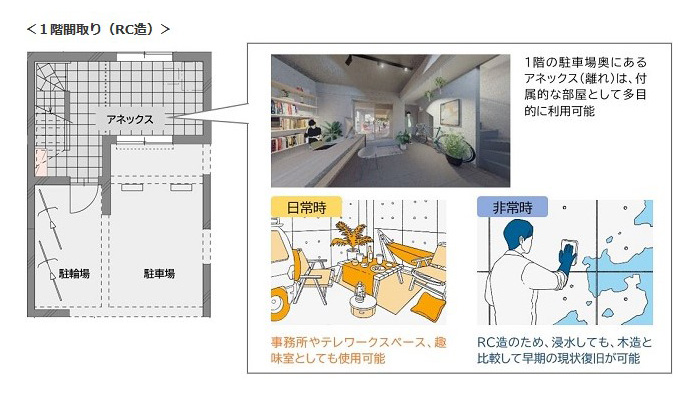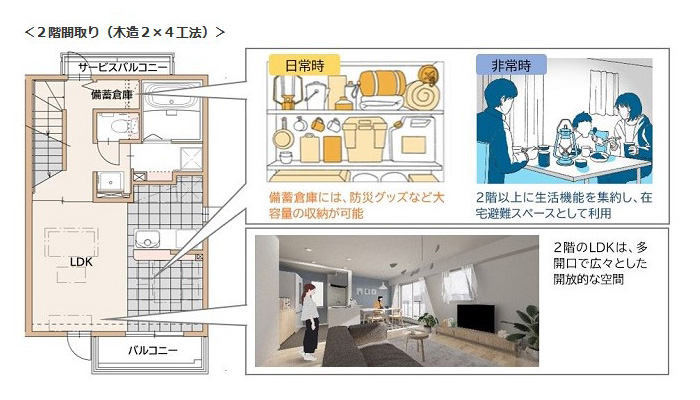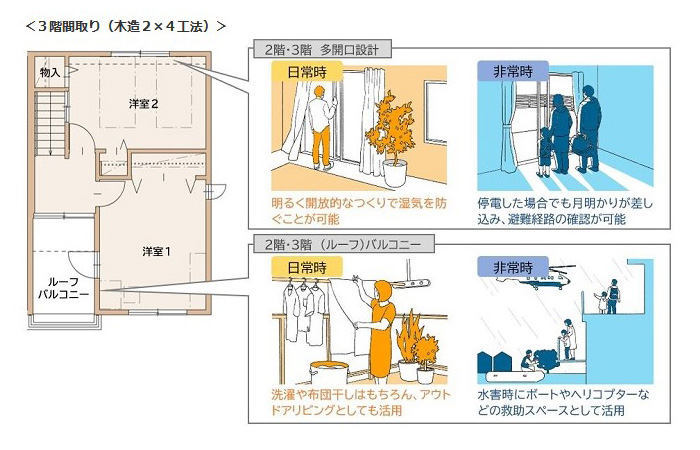Notes
(*1) Bo-Ku Lab Disaster Prevention and Living Research Laboratory(only available in Japanese)
(*2) "niimo" received an award of excellence at the 5th EcoPro Awards sponsored by the Sustainable Management Promotion Organization, Japan, in recognition of its development from the perspective of "adaptation" to prepare for the effects of climate change.
(*3) The idea that it is important to naturally incorporate disaster preparedness into daily life.
(*4) A method in which tiles or other finishes are omitted and bare concrete with the formwork removed is used as the finish.
Disaster-Resilient Rental Housing Resistant to Flooding and Remains Usable After a Disaster
Daito Trust Construction Co., Ltd.
| Publication date | June 6, 2023 (Posted on May 10, 2024) |
|---|---|
| Sector | Natural Disasters and Coastal Areas / Life of Citizenry and Urban Life |
Company Overview

Daito Trust Construction Co., Ltd. was established in 1974 for the purpose of constructing rental buildings. Based on the corporate philosophy of "contributing to society by realizing extensive and effective use of limited land," the company is currently engaged in planning and construction of building rental business, real estate brokerage and management, and related businesses such as gas supply as the Daito Group.
Climate Change Impacts
In recent years, the occurrence of flood damage due to heavy rains and overflowing rivers caused by climate change has become frequent. According to the percentage of our managed properties damaged by Typhoon No. 19 and No. 20 in 2019, 61.6% of the properties were inundated above floor level (50 cm to 1 m above the ground). After flooding, in addition to the removal of soil and sand, etc., hygiene maintenance such as replacing furniture and disinfection is necessary to prevent contagious diseases due to bacteria mold in sewage and bad odor.
Adaptation Initiatives
As part of the Daito Group's Disaster Prevention and Living Research Project, “Bo-Ku Lab (*1)," Daito has developed "niimo," a disaster-resilient rental housing specialized in flood countermeasures (*2).
The concept of "niimo" is "phase-free" (*3), indicating that everyday life itself becomes preparation for emergencies, and it is designed so that residents can continue living in their homes right after a disaster and during recovery efforts (Figs. 1 to 5). Specifically, it has the following features.
- The first floor is finished with fair-faced concrete, which makes early restoration relatively easy even in the event of flooding (*4).
- The second and third floors, which have an extremely low possibility of flooding, are constructed using the 2×4 wooden construction method, and the living spaces are concentrated.
- The stairwell is a three-story atrium. Ventilation allows air to flow through the space, enabling the building to dry out dampness at an early stage in the event of flooding.
- Designed to avoid damage from submersion in the event of flooding (electrical outlets on the first floor are located high up near the ceiling, and outdoor units for air conditioners are located on the second floor or above).
Effects / Expected Benefits
Designed to allow residents to continue living in their homes right after a disaster or during recovery efforts, this product is expected to reduce the physical, mental, and emotional burdens associated with evacuation right after a disaster occurs or mid- to long-term housing relocation due to "flood risk". Developed based on the concept of "phase-free," this product also improves the quality of life (QOL) in any situation, as various innovations and preparations are useful not only during everyday life but also in times of emergencies.




Fig. 5 Flood-resistant house designed to “not” prepare for disaster prevention (video)

